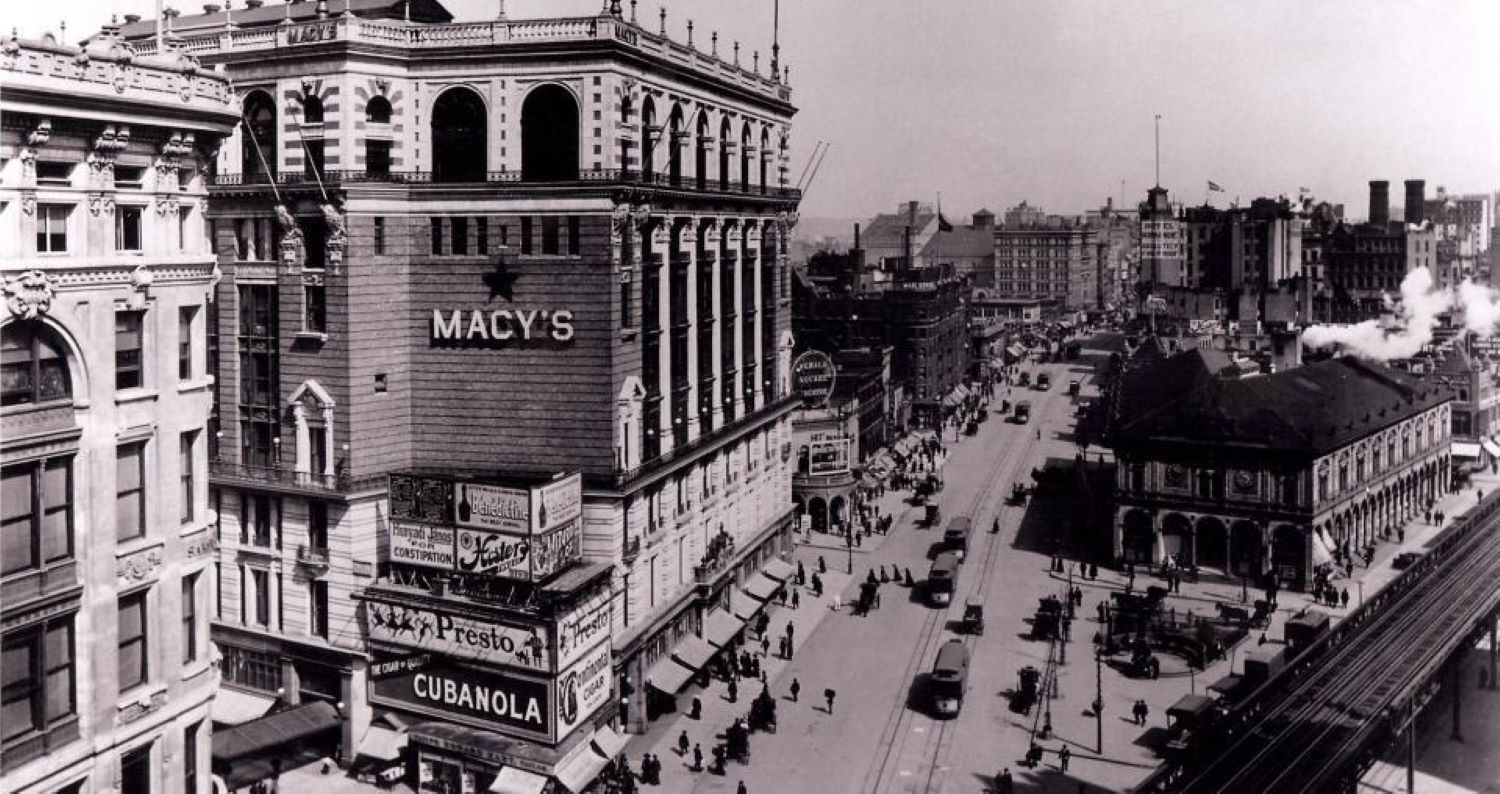Macy’s in Crisis: The Retail Giant’s Decline and Recovery Efforts
The retail industry is more dynamic than ever. It is experiencing significant transformation due to shifts in consumer preferences, advancements in technology, and evolving market dynamics, creating a constantly changing environment.
E-commerce has surged as a leading influence, driven by the widespread embrace of digital innovations, mobile shopping, and evolving consumer habits.
Macy’s, an iconic name in department store retailing, has established itself as a symbol of quintessential American culture and values over its nearly two centuries of operation.
However, in 1990, Macy’s stood outside the top 10 U.S. retailers. But the 1990s aren’t the only period that highlights Macy’s misstep. They’ve experienced a significant decline over the course of many years.
Before delving into the reasons behind, let’s first explore the early days of Macy’s.
Macy’s Origins: From Humble Beginnings to Retail Giant
Rowland Hussey Macy established a conventional dry goods store in Manhattan, which bore his own name.
The early struggles faced by Rowland Hussey Macy were significant, with only $11 in sales on the first day. However, his determination and vision propelled the business forward, and within a year, the store had amassed $85,000 in revenue.
First, the key factor contributing to Macy’s success was its pioneering pricing strategy. By adopting the practice of pricing items just below whole-dollar amounts, such as selling goods for $1.99 instead of $2, Macy’s tapped into consumer psychology, making products appear more affordable and enticing. This strategy, along with a cash-only policy, ensured consistent revenue generation for the company.
The move to the flagship store on 34th Street in 1902 marked a milestone in Macy’s history. Equipped with modern conveniences such as escalators, Macy’s flagship store set new standards for retail experiences.
In 1924, Macy’s cemented its status as a retail giant with the inclusion of the world’s largest store. This monumental achievement turned the flagship location into a tourist attraction, drawing visitors from around the globe. Macy’s became synonymous with extravagance, particularly during the holiday season, with its elaborate Christmas displays and department store Santa.
The 1920s also saw Macy’s expanding its reach beyond New York City through the acquisition of regional retail chains. Notable acquisitions, such as Bam Burgers in New Jersey, contributed to Macy’s continued growth and profitability.
By the 1950s, Macy’s had emerged as the largest department store chain in the United States.
However, in 1952, Macy’s encountered its first-ever reported loss, signaling a period of relative stagnation in the following decades.
While still a prominent fixture in American retail, Macy’s was perceived as a reliable but unremarkable choice for shoppers. A shift in leadership in the late 1970s breathed new life into the company.
Under new leadership, Macy’s undertook a series of bold initiatives aimed at revitalizing the brand and driving growth. These efforts, dubbed the “Merchandising Miracle” or the “Macy’s Miracle,” proved highly successful, leading to increased sales and profits across various metrics.

One crucial facet of Macy’s revitalization strategy was the remodeling of stores, including the flagship location on 34th Street. By highlighting the most profitable departments and eliminating less profitable ones, Macy’s sought to optimize its store layout for maximum efficiency and profitability.
A particularly innovative move was the transformation of the basement space into a unique shopping destination called “the Cellar.” Inspired by a concept introduced at Macy’s San Francisco location, the Cellar offered a diverse array of products, including restaurants, food items, cookware, and cooking demonstrations.
Besides, a change in New York law in 1976 allowed stores to open on Sundays, granting Macy’s an extra day of commerce every week. This change proved beneficial, particularly as many Sunday customers were women who took advantage of the opportunity to shop while their husbands watched football, contributing to increased sales.
The Erosion of Macy’s: Factors Behind the Retail Giant’s Decline
With momentum building as more customers flocked to Macy’s, the company made significant investments to sustain growth into the 1980s. These investments included increasing inventory levels to ensure product availability, ramping up advertising expenses to attract more customers, enhancing customer service, expanding private label brands, and opening new stores, particularly in the southern United States.
The opening of a large store in Dallas in 1985 underscored Macy’s commitment to expansion and solidified its presence in new markets.
However, those strategy’s unforeseen drawbacks sparked a chain of events that ultimately led to Macy’s filing for bankruptcy in 1992.
Expanding Amid Economic Downturn: Macy’s Move in 1992
The dramatic slowdown in the US economy during the early 1990s presented significant challenges for retailers, including Macy’s. With consumers tightening their belts and spending less, Macy’s found itself grappling with declining revenues despite having recently increased expenses.
This proved to be particularly problematic timing for Macy’s, as their heightened costs did not yield the expected boost in revenue, leading to falling profits.
As a response to the mounting financial pressures, Macy’s executives made a bold move in 1992. In a leveraged buyout valued at $3.7 billion, 300 Macy’s executives collectively took the company private, effectively removing it from the stock market.
While this decision added a substantial amount of debt to Macy’s balance sheet, the executives justified the buyout by stating that Macy’s needed time to regroup and that going private would shield them from the short-term pressures of the stock markets.
Furthermore, the buyout was seen as a defensive measure against potential hostile takeovers, especially considering Macy’s declining stock price, which made the company vulnerable.
However, Macy’s financial woes deepened further due to previous risky acquisitions. In 1988, Macy’s had acquired two California-based retail chains for over one billion dollars, significantly increasing its debt burden.
By 1992, Macy’s found itself in dire straits, ultimately leading to the company filing for bankruptcy with liabilities totaling $5.3 billion.
Following its bankruptcy, Macy’s underwent a transformation, culminating in its acquisition by Federated Department Stores.
Federated, already owning multiple retail chains, notably Bloomingdale’s, saw an opportunity to create synergy by merging with Macy’s. This union formed the largest department store conglomerate in the country, a great move amidst the struggles department stores faced in competing with burgeoning discount retailers like Walmart.
Subsequent acquisitions, such as the Broadway stores on the West Coast in 1995 and May Department Stores in 2005, further solidified Macy’s presence in key markets.
While the process was complex, involving the integration of diverse retail chains, many of these entities were eventually converted into Macy’s stores.
Leveraging Macy’s strong brand recognition, Federated Department Stores rebranded itself as Macy’s in 2007, signaling a tactical shift towards centralizing the company around its flagship brand.
The Long-Term Battle with E-commerce
Since the emergence of e-commerce in 2012, Macy’s has experienced a significant and continuous decline in its business performance.
Revenue has been declining at an annual rate of 4.0% from 2012 to 2017, according to IBISWorld. Although the rate of decline is expected to lessen in the next five years, Macy’s, holding the largest share of the industry at 11.7%, still faces uncertain growth prospects.
Compounding these challenges is the shrinking profit margin, despite Macy’s initially having a higher margin compared to the industry average of 2.6%. Intense price competition with e-commerce businesses has led to a narrowing gap between Macy’s profit margin and the industry average.

Moreover, alongside competition, Macy’s must contend with a high corporate tax rate, which significantly exceeds that of e-commerce businesses like Amazon.
Despite Amazon’s significantly higher net sales compared to Macy’s, the tax paid by Amazon since 2008 is only 30% of Macy’s tax burden. This disparity in corporate tax rates constrains Macy’s long-term profitability.
Competition within the industry poses further concerns. Macy’s holds the highest market share but exhibits the lowest growth rate, whereas competitors like Nordstrom demonstrate the opposite trend.
Nordstrom’s higher growth rate, coupled with favorable performance across various dimensions such as brand recognition, product diversity, customer service, and online channels, positions it as a formidable competitor.
A comparison of brand equity among Macy’s and its competitors reveals Nordstrom’s dominance, particularly in areas such as product diversity, customer service, and online channels.
Despite Macy’s and JCPenney’s strengths in brand recognition and offline distribution, Nordstrom’s comprehensive advantages across multiple dimensions make it the most competitive player in the industry.
The Death of Department Store and Middle Class
Department stores across the United States have been shrinking or closing altogether, marking a significant shift in the retail landscape.
In 2011, the sector employed 1.2 million workers across 8,600 stores, but by 2020, these numbers had plummeted to fewer than 700,000 employees working across just over 6,000 locations, according to estimates from the research firm IBISWorld.
The reasons behind this decline are multifaceted. Since the onset of the Great Recession in late 2007, a substantial portion of income growth in the US has been concentrated among high-income households, while middle-class households have experienced financial strain.
This economic shift has reshaped consumer spending habits, with discount chains like TJ Maxx, Ross, and Dollar General gaining popularity, drawing customers away from traditional department stores such as Macy’s, which once catered to a robust middle class.
Moreover, the role of department stores as primary hubs for discovering and accessing new brands has diminished. Consumer brands increasingly prioritize direct connections with customers through their own stores, websites, and social media platforms, sidelining department stores as intermediaries.
The contraction of department stores has broader implications for local labor markets and communities. More than half of all mall-based department stores are projected to close by the end of 2021, according to estimates by Green Street Advisors, profoundly impacting malls, where department stores traditionally occupied a significant share of retail space.

According to Sucharita Kodali from Forrester, “The shift in real estate has been to what we call mixed-use facilities or a lot of the outdoor strip centers,”.
Furthermore, consumers today have a plethora of options when it comes to shopping for apparel.
“They’re buying more clothes at Costco and Walmart to Amazon and, you know, kind of apparel stores like H&M, Zara, Shein, Temu and the list goes on,” Kodali said.
Jessica Ramírez, representing Jane Hali and Associates, highlights another obstacle for Macy’s: the retailer’s product offerings may not align with modern consumer preferences. Macy’s may struggle to provide the tailored, contemporary products that shoppers are seeking, which further exacerbates its challenges in attracting and retaining customers.
Macy’s vs. Amazon: A Retail Collision
Macy’s has found itself in direct competition with the Amazon juggernaut, a clash that has underscored the challenges facing traditional brick-and-mortar retailers in the digital age. While it’s convenient to attribute the downturn in physical retail solely to Amazon’s dominance, Macy’s has faced its own set of obstacles, compounded by Amazon’s astute decision-making.
Amazon’s seamless online shopping experience, punctuated by swift delivery options and hassle-free returns, has redefined consumer expectations and habits. In contrast, Macy’s has struggled to fully leverage its considerable physical retail footprint, failing to capitalize on the inherent advantage of in-store experiences.
Research indicates that a significant portion of consumers still prefer in-store shopping for the tactile experience it offers. Furthermore, there is a notable shift towards prioritizing services and experiences over mere material possessions.
Amazon’s foray into physical retail underscores this trend, highlighting Macy’s missed opportunity to differentiate itself through in-store promotions and events.
The disparity in online apparel sales between Amazon and Macy’s speaks volumes. With Amazon comfortably leading the pack at over $16 billion in September, Macy’s lagged behind at just over $6 billion.
Most analysts have confidently predicted that Amazon will soon overtake Macy’s as the largest seller of clothing in the U.S., signaling a significant shift in the retail landscape.
Evolving with Retail Trends: Macy’s Store Adaptation

Macy’s Closure of 150 Stores
In reaction to changing consumer preferences and market dynamics, Macy’s has unveiled a turnaround plan aimed at revitalizing its brand and positioning itself for future success.
Central to this plan is the closure of 150 underperforming stores, with 50 slated to shut down by the end of 2024 and the remaining 100 over the next few years. By 2026, Macy’s will streamline its footprint to just 350 stores, reflecting a deliberate move towards a leaner, more efficient operational model.
Besides, Macy’s will focus on leveraging the success of its upscale brands, Bloomingdale’s and Bluemercury, which have consistently outperformed the flagship Macy’s brand. The company plans to expand these luxury stores by opening more, smaller versions over the next several years, catering to affluent shoppers who continue to prioritize quality and exclusivity.
This shift underscores a broader trend in the retail market, as the middle class has experienced significant shrinkage in recent decades. As a result, consumer preferences have become increasingly polarized, with lower-end discount retailers like Walmart thriving alongside luxury brands catering to affluent shoppers.
Macy’s Push for Modernization
Macy’s has been proactive in adapting to the ever-changing landscape of retail, implementing fresh ideas to resonate with modern shoppers’ evolving preferences. Venturing into the world of NFT auctions marked a bold embrace of digital trends.
Furthermore, Macy’s decision to revive Toys ‘R’ Us shops tapped into nostalgia, delighting many who longed for the beloved toy store chain. This strategic move highlighted Macy’s determination to reinvent itself amidst the rapid transformations within the market.
In addition to these innovative initiatives, Macy’s maintains a diverse product offering, comprising both private brands and national brands such as Ralph Lauren, Calvin Klein, and Levi Strauss. With approximately 25 private brands spanning categories like apparel and home goods, including On 34th, Macy’s has cultivated a distinct identity within the retail landscape.
Moreover, Macy’s has strategically recruited talent from reputable retailers renowned for their strong brand identities. Notably, individuals like Emily Erusha-Hilleque, a seasoned veteran of Target with 23 years of experience, now serve as Macy’s senior vice president of private brands.
Similarly, Bryan Riviere, with an extensive background at Gap-owned Banana Republic, Levi Strauss, Lululemon, and Nike, brings valuable expertise to Macy’s as its senior vice president of private brand sourcing, product development, and production.
Considering a Buyout: Macy’s Evaluating Alternatives
Macy’s has recently received an increased buyout proposal from two investment firms, Arkhouse Management and Brigade Capital Management.
Arkhouse Management and Brigade Capital Management proposed to acquire Macy’s for $24 per share in cash, increasing their offer from an earlier $21 per share. The proposition is enticing considering Macy’s stock performance, which has not been favorable since the early 2010s. Macy’s shares have plummeted by over 70% from their peak in July 2015.
However, certain analysts and investors believe that Macy’s could hold a significantly higher value, valuing the company’s real estate assets alone at over $30 per share.
Macy’s has stated through a letter from chairman and former CEO Jeff Gennette, attached to Arkhouse’s proxy statement dated March 11, that its board is not presently ready to engage in a transaction at the current price level.
However, the company has shifted its stance from previous months and has agreed to enter into negotiations and sign a confidentiality agreement to facilitate due diligence for Arkhouse and its affiliates, as mentioned in the filing.
Another bidder may have entered the fray. Shares of Macy’s surged nearly 4% following reports that private equity firm Sycamore Partners, known for its retail and consumer investments, is considering taking the department store private. While Macy’s declined to comment on the latest offer, Sycamore Partners has yet to respond to inquiries.
Despite the proposed premium offered in the buyout bid, Macy’s may need to reassess its options in light of ongoing market challenges and evolving consumer preferences.









